STED Microscopy
Purity/quality of the sample needed
- Nothing which auto fluoresces in the red to far red can be in the medium, mount, or sample itself (e.g. no phenol red in cell medium)
Amount needed for a typical measurement
- At least one coverslip, preferably with at least one successful labelling (e.g. fluorescently labelled cell) per field of view of 80x80m
Approximate concentration (or concentration range) which is suitable for measurement.
- Not applicable
Any other appropriate requirements:
- Please contact the RUG-site, which can provide sample specific input and advice on optimal preparation methods.
- In general, the following fluorescent labels can be used:
- For confocal resolution, standard dyes or fluorescent proteins with 405 nm laser excitation
- For confocal resolution, standard dyes or fluorescent proteins with 488 nm laser excitation
- For STED resolution, NO fluorescent proteins, but STED suitable dyes (a.o. abberior dyes, SiR 647, Janelia Farm dyes for excitation 560 or 640 nm) either directly bound (e.g. SiR-actin), through e.g. SNAP- CLIP- or Halo-labelling, or through secondary antibody labelling.
- Please note that blue (405 nm) dyes close to the structure of interest to study by STED will give significant background due to two photon excitation of the STED laser (so no Dapi labelling when DNA bound/nuclear structures are studied by STED).
- All samples should be mounted on a glass coverslip with thickness #1.5 (170 µm)
- For fixed samples, the coverslip should be mounted on a standard microscope glass slide using Mowiol or a similar mounting medium which does not auto-fluoresce, even in the red to far red. Living samples should have been grown on #1.5 thickness coverslips, contact us for suitable sizes and procedures.
- A single (not multiple!) coverslip should be mounted in the middle of the microscope glass slide.
Solid-state NMR
Purity/quality of the sample needed
- Solid-state NMR can analyse (semi)solid samples of various degrees of heterogeneity and complexity. More detailed insights are attainable if the sample is pure and homogeneous.
Amount needed for a typical measurement
- The ssNMR sample volume is approximately 15-30 µL. This volume is filled with the (semi)solid material of interest, implying between 1 and 20 mg of the protein/lipid/macromolecules, plus extra hydration water or buffer.
Approximate concentration (or concentration range) which is suitable for measurement.
- Final samples are pelleted into a max 30 µL volume, but samples can be delivered as a suspension with between 1-20 mg of protein/lipids in a volume of max 2-3 mL water/buffer.
Any other appropriate requirements:
- General considerations for ssNMR dynamic & structural characterization:
- Stable isotope labelling of proteins with 13C and/or 15N maximizes the information content and is strongly advised, though not required.
- Consultation on labelling strategies (or feasibility without labelling) is available.
- Biophysical characterization by ssNMR is ideally done on wet, gel-like or otherwise hydrated semi-solid samples, such that biologically relevant motion can be detected.
- Lipid membrane studies:
- SSNMR allows measurements of lipid bilayer thickness, lipid phase behaviour, lipid dynamics, and detection of non-bilayer phases.
- This can be done on LUVs or MLVs, with complex lipid compositions, and in presence or absence of polypeptides.
- Isotope-labelling of the lipids is often not required, though incorporation of deuterium labelled lipids can be helpful for specific measurements.
- Protein aggregate and oligomer studies:
- SSNMR studies of protein aggregates with unlabeled protein samples are in principle feasible for qualitative insights into overall structure and dynamics.
- Residue- or domain-specific results require 13C (and/or 15N) labelling, via 2D spectroscopy. We can offer advice for proteins produced in E. coli.
- Other sample types:
- Also feasible: other biomolecules and biopolymers, including polysaccharide hydrogels, extracellular matrix preparations and cell pellets.
- Data on solvent mobility and interactions are also available.
- The RUG site can provide the MAS NMR sample holders for on-site sample preparation with user-provided sample suspensions/powders. If users want to bring pre-packed samples, then Bruker-style 3.2 mm MAS rotors are required.
- For on-site sample preparation, special packing devices are available that facilitate sample sedimentation at up to 150,000 x g. For use of these devices, it is ideal to have the total sample present as a suspension in a volume of max. 2 mL.
AFM and Optical tweezers
Purity/quality of the sample needed
- Especially for AFM the sample needs to be very pure, crystallography grade.
Amount needed for a typical measurement
- ~100 µl is a rough volume guide line
Approximate concentration (or concentration range) which is suitable for measurement.
- This depends on the sample. As a guide line having a stock solution of 1 mg/ml is a good start to optimise the parameters for AFM. Stock solutions are typically diluted before the start of the experiment. Experiments for optical tweezers are typically performed in the nM range of concentrations.
Any other appropriate requirements:
- Due to the wide diversity of possible samples, it is always good to discuss first the possibilities and limitations of the set-ups for a certain type of experiment and sample.
